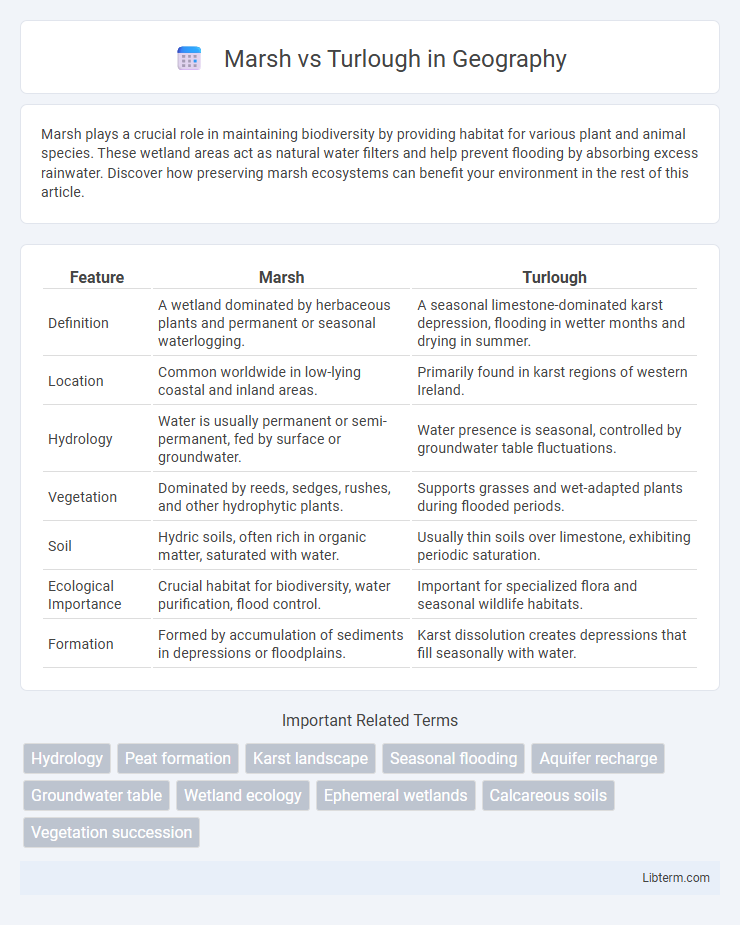Marsh plays a crucial role in maintaining biodiversity by providing habitat for various plant and animal species. These wetland areas act as natural water filters and help prevent flooding by absorbing excess rainwater. Discover how preserving marsh ecosystems can benefit your environment in the rest of this article.
Table of Comparison
| Feature | Marsh | Turlough |
|---|---|---|
| Definition | A wetland dominated by herbaceous plants and permanent or seasonal waterlogging. | A seasonal limestone-dominated karst depression, flooding in wetter months and drying in summer. |
| Location | Common worldwide in low-lying coastal and inland areas. | Primarily found in karst regions of western Ireland. |
| Hydrology | Water is usually permanent or semi-permanent, fed by surface or groundwater. | Water presence is seasonal, controlled by groundwater table fluctuations. |
| Vegetation | Dominated by reeds, sedges, rushes, and other hydrophytic plants. | Supports grasses and wet-adapted plants during flooded periods. |
| Soil | Hydric soils, often rich in organic matter, saturated with water. | Usually thin soils over limestone, exhibiting periodic saturation. |
| Ecological Importance | Crucial habitat for biodiversity, water purification, flood control. | Important for specialized flora and seasonal wildlife habitats. |
| Formation | Formed by accumulation of sediments in depressions or floodplains. | Karst dissolution creates depressions that fill seasonally with water. |
Introduction to Marsh and Turlough Ecosystems
Marsh ecosystems are wetlands characterized by herbaceous plants such as grasses, sedges, and reeds, often found along freshwater or tidal shores, providing crucial habitats for diverse wildlife and supporting nutrient cycling. Turloughs are seasonal limestone depressions unique to karst landscapes, predominantly found in regions like Ireland, where water levels fluctuate dramatically, creating temporary aquatic habitats critical for specialized flora and fauna. Both ecosystems play vital roles in biodiversity conservation, water filtration, and flood regulation within their respective environmental contexts.
Defining Marshes: Characteristics and Types
Marshes are wetlands characterized by water-saturated soils, abundant herbaceous plants, and poor drainage, supporting diverse ecosystems. They are typically classified into freshwater and saltwater types, with freshwater marshes found inland around rivers and lakes, and saltwater marshes located along coastlines influenced by tides. Key features include periodic flooding, nutrient-rich sediment accumulation, and vegetation such as cattails, reeds, and grasses adapted to wet conditions.
Understanding Turloughs: Unique Features and Formation
Turloughs are seasonal karstic features predominantly found in limestone regions, characterized by intermittent flooding and drainage influenced by groundwater levels. Their formation results from the dissolution of carbonate bedrock, creating underground cavities that temporarily store water during wet seasons before draining in drier periods. Understanding turloughs is essential for ecological studies and groundwater management due to their unique hydrological dynamics and biodiversity.
Geographic Distribution of Marshes vs Turloughs
Marshes are widespread across temperate and tropical regions, characteristically found in coastal plains, river valleys, and low-lying inland areas with year-round water saturation. Turloughs, predominantly located in karst landscapes of Ireland, exhibit a unique seasonal flooding pattern influenced by underground limestone drainage systems. This geographic distinction highlights marshes' general global presence versus turloughs' specific occurrence in carbonate rock environments.
Hydrology: Water Sources and Seasonal Dynamics
Marsh ecosystems depend on a delicate balance of water sources, including precipitation, groundwater influx, and surface runoff, which influence their hydrological regime. Turloughs, unique karst features found primarily in Ireland, experience seasonal flooding due to underground water table fluctuations, filling basins in wetter months and drying during drier periods. Understanding the contrasting water sources and seasonal dynamics of marshes and turloughs is critical for effective hydrological management and biodiversity conservation in these distinct wetland habitats.
Biodiversity: Flora and Fauna in Marshes and Turloughs
Marshes support diverse plant species such as sedges, reeds, and rushes, creating vital habitats for amphibians, birds, and aquatic insects. Turloughs, seasonal lakes unique to karst landscapes, host specialized flora adapted to fluctuating water levels, including wet grasslands and ephemeral aquatic plants. The dynamic hydrology of turloughs fosters distinct biodiversity patterns, contrasting with the more stable, waterlogged conditions of marshes that sustain year-round wetland ecosystems.
Ecological Roles and Environmental Significance
Marshes play a critical ecological role by providing habitat for diverse wildlife, including amphibians, birds, and invertebrates, while filtering pollutants and improving water quality through natural biofiltration processes. Turloughs, seasonal karst lakes typically found in limestone regions, support unique amphibious and aquatic species adapted to fluctuating water levels, contributing to biodiversity in otherwise dry landscapes. Both ecosystems regulate hydrological cycles, mitigate flooding, and act as carbon sinks, underscoring their environmental significance in climate resilience and ecosystem services.
Threats and Conservation Challenges
Marsh and Turlough habitats face significant threats from agricultural expansion, water pollution, and habitat fragmentation, leading to decreased biodiversity and altered hydrological cycles. Invasive species pose a substantial risk by outcompeting native flora and fauna, while climate change exacerbates water level fluctuations, impacting the delicate balance of these ecosystems. Conservation challenges include maintaining natural water regimes, controlling invasive species, and implementing sustainable land-use practices to protect and restore the ecological integrity of marshes and turloughs.
Human Uses and Cultural Importance
Marshes serve as vital habitats supporting biodiversity and providing resources for traditional activities such as fishing, hunting, and foraging, integral to many indigenous cultures. Turloughs, seasonal limestone depressions unique to karst landscapes in Ireland, hold cultural significance through folklore and have historically influenced local agriculture and settlement patterns. Both ecosystems support human livelihoods by maintaining water quality and offering ecological services critical to community sustainability.
Key Differences and Comparative Summary
Marsh involves the liability of occupiers for injuries caused by natural accumulations of ice and snow on their property, emphasizing the duty to warn or reasonably protect visitors. Turlough centers on the liability for artificial or man-made causes of harm, highlighting stricter responsibilities in maintaining safe conditions. The key difference lies in the nature of the hazard--natural versus artificial--and the extent of the occupier's duty to mitigate or warn against these dangers.
Marsh Infographic

 libterm.com
libterm.com